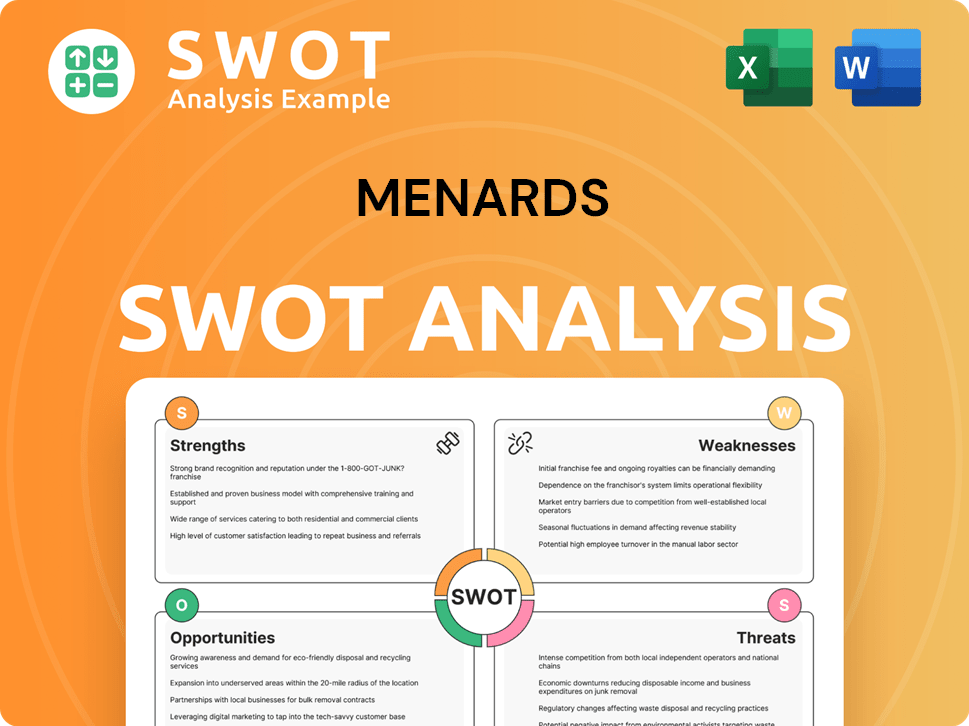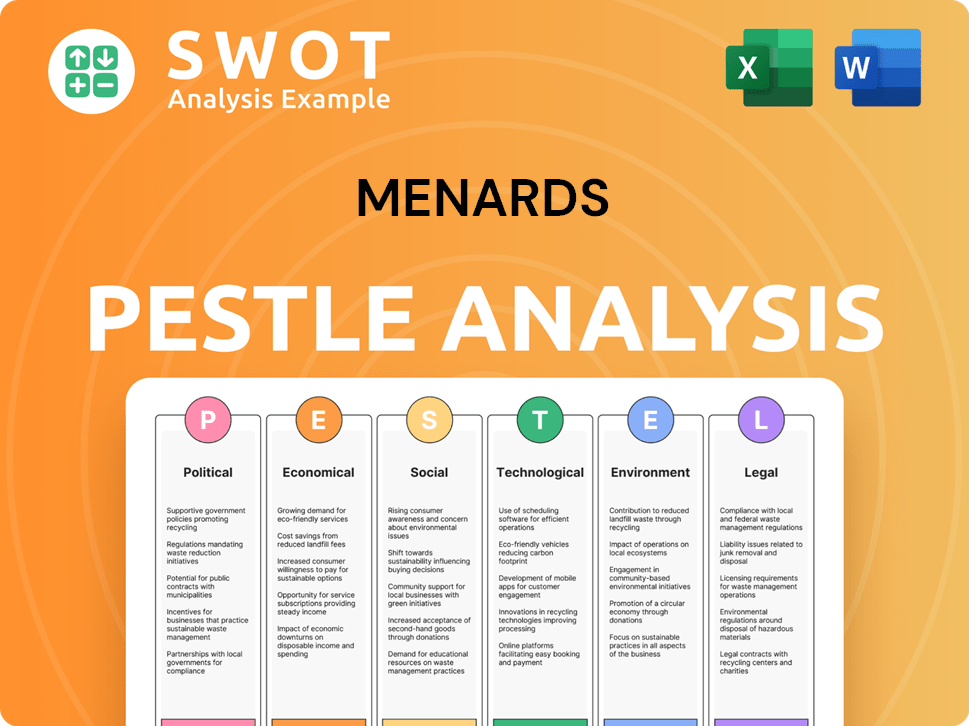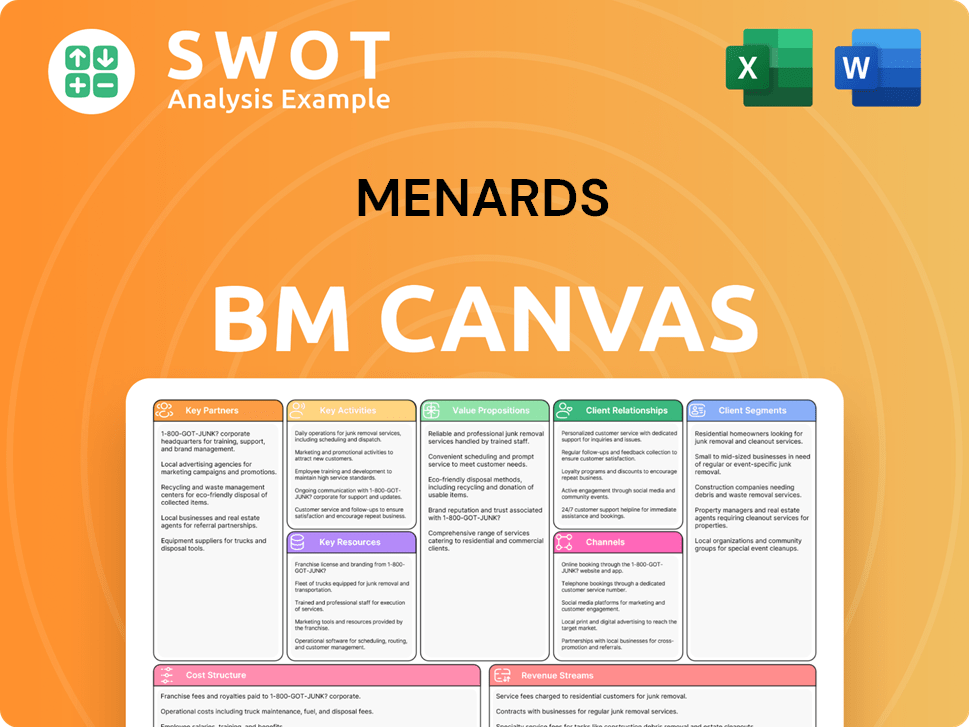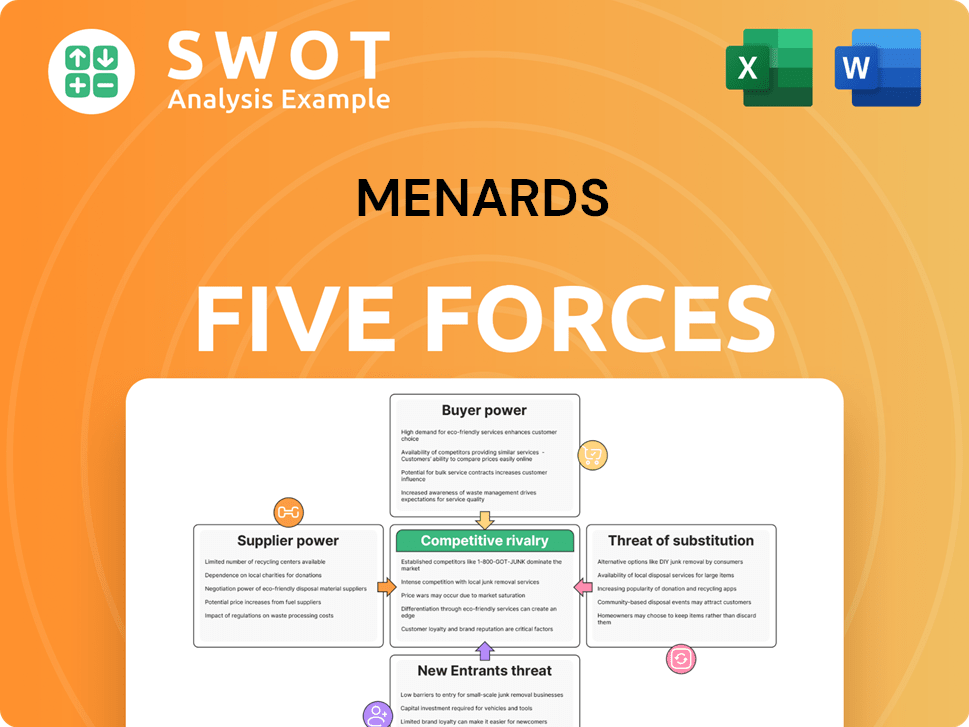Menards Bundle
Who Really Calls the Shots at Menards?
Unraveling the mystery of 'Who owns Menards?' is key to understanding the strategies driving this retail giant. Unlike its publicly-traded competitors, Menards operates under a private ownership model, which significantly impacts its operations and long-term vision. This unique structure allows Menards to navigate the competitive landscape with a focus often unachievable by companies beholden to quarterly reports.

Founded in 1960 by John Menard Jr., Menards, officially Menard, Inc., has grown from a post-frame building company to a major home improvement retailer. The Menards SWOT Analysis reveals how this private status influences its market position and strategic decisions. Understanding the Menards owner and the Menards company ownership is crucial for investors and business strategists alike. Delving into the Menards parent company and Menards headquarters provides a deeper understanding of the company's trajectory.
Who Founded Menards?
The story of the company, begins in 1960 with John Menard Jr. as its founder. Initially, he started the business by building pole barns to fund his college education. This venture quickly evolved into selling building materials, marking the beginning of what would become a retail giant. The early ownership structure was straightforward, with John Menard Jr. at the helm, maintaining significant control of the company from its inception.
Due to its private nature, specific details about equity splits or initial shareholding percentages from the very beginning are not available publicly. However, it is widely understood that Menard Jr. was the sole proprietor and the driving force behind the establishment and early growth of the company. This concentrated ownership allowed for swift decision-making and a consistent strategic direction.
The company's expansion was largely fueled by its own profits and strategic reinvestment rather than external capital infusions. This self-funded approach allowed John Menard Jr. to retain tight control and steer the company according to his long-term vision without external pressures. The company's structure from the outset reflected John Menard Jr.'s entrepreneurial spirit and his desire to build a business under his direct supervision.
The early ownership of the company was primarily vested in John Menard Jr., who founded the company. There were no significant initial backers or angel investors during the company's early phases. The company's growth was largely self-funded, allowing John Menard Jr. to maintain control. The concentrated ownership structure facilitated swift decision-making and a consistent strategic direction. For more insights, consider reading about the Growth Strategy of Menards.
- The company's initial focus was on pole barn construction.
- John Menard Jr. used the business to finance his college education.
- The company's expansion was primarily driven by reinvesting profits.
- There were no reported initial ownership disputes or buyouts.
Menards SWOT Analysis
- Complete SWOT Breakdown
- Fully Customizable
- Editable in Excel & Word
- Professional Formatting
- Investor-Ready Format

How Has Menards’s Ownership Changed Over Time?
The ownership structure of Menards, a privately held company, differs significantly from publicly traded entities. The company's history doesn't include an initial public offering (IPO) or a shift in ownership to public shareholders. Instead, the ownership has largely remained within the Menard family. The founder, John Menard Jr., continues to hold a dominant stake in the company. This concentrated ownership model has profoundly influenced the company's strategic direction and governance.
The absence of external investors or venture capital rounds is a key characteristic of Menards' ownership evolution. The company has historically funded its growth through retained earnings, allowing the Menard family to maintain complete control and avoid diluting their ownership. This approach has enabled the company to pursue long-term strategies, often characterized by aggressive cost-cutting and a focus on operational efficiency, without the pressure of short-term financial targets.
| Aspect | Details | Impact on Ownership |
|---|---|---|
| Founding | Founded by John Menard Jr. | Established family ownership as the cornerstone. |
| Funding Strategy | Growth financed through retained earnings. | Maintained family control and avoided external shareholders. |
| Public Status | Privately held; no IPO. | Shielded from public market pressures and scrutiny. |
The current major stakeholders of Menards primarily consist of John Menard Jr. and other members of the Menard family. While the specific roles and equity allocations of individual family members are not publicly available, their collective ownership signifies a continued commitment to the family's vision for the company. Unlike public companies, Menards is not required to disclose major institutional investors or mutual funds. This private status allows for a consistent approach to retail operations, influencing the company's strategy and governance. For more insights, consider exploring the Competitors Landscape of Menards.
John Menard Jr. is the primary Menards owner, maintaining a dominant stake. The company's ownership structure is centered around the Menard family.
- Menards is a privately held company.
- The company has historically financed its growth through retained earnings.
- The Menard family maintains complete control.
- This structure allows for long-term strategic planning.
Menards PESTLE Analysis
- Covers All 6 PESTLE Categories
- No Research Needed – Save Hours of Work
- Built by Experts, Trusted by Consultants
- Instant Download, Ready to Use
- 100% Editable, Fully Customizable

Who Sits on Menards’s Board?
As a privately held entity, information regarding the board of directors for the Menards company ownership is not publicly available through standard channels like SEC filings. The composition of the board, including the names and roles of its members, is not disclosed. However, it is widely understood that the board likely includes key family members and long-tenured executives who are aligned with the vision of the Menard family. This structure is typical for privately held companies, where control is concentrated within the founding family.
Given the private nature of the Menards parent company, the board's structure and governance operate differently from those of publicly traded corporations. The absence of public disclosure means there are no readily available details on the board's specific composition, committees, or meeting frequency. The primary focus remains on the interests of the major shareholders, primarily the Menard family, who hold significant voting power. The company's decision-making processes are centralized, reflecting the family's direct ownership and control.
| Aspect | Details | Implication |
|---|---|---|
| Public Disclosure | Limited to none | Lack of transparency compared to public companies. |
| Board Composition | Likely includes family members and long-term executives. | Focus on family interests and long-term strategic vision. |
| Voting Power | Concentrated with the Menard family. | Centralized control over strategic direction and operations. |
The ultimate control of the Menards company ownership rests with John Menard Jr. and his family. This concentration of ownership allows for streamlined decision-making and insulates the company from external shareholder pressures. Unlike publicly traded companies, there are no proxy battles or activist investor campaigns to consider. The focus remains on the long-term strategic vision and operational decisions set by the Menard family. To understand more about the company's approach, you can also explore the Marketing Strategy of Menards.
The Menards owner, John Menard Jr., and his family hold significant control over the company.
- The board likely includes family members and long-term executives.
- Decision-making is centralized, reflecting the private ownership structure.
- There is no public information about the board of directors.
- The company is insulated from external shareholder pressures.
Menards Business Model Canvas
- Complete 9-Block Business Model Canvas
- Effortlessly Communicate Your Business Strategy
- Investor-Ready BMC Format
- 100% Editable and Customizable
- Clear and Structured Layout

What Recent Changes Have Shaped Menards’s Ownership Landscape?
Over the past few years, the ownership structure of the company has remained stable. The Menard family, with John Menard Jr. at the helm, continues to hold dominant control. This private ownership model sets it apart from many large retail chains, which often experience shifts due to public offerings or institutional investor influence. Unlike publicly traded companies, the company isn't subject to the pressures of quarterly earnings reports or short-term market fluctuations, allowing for a long-term strategic focus.
The company's focus has been on organic growth and expanding its store footprint, primarily within the Midwest. The absence of public ownership changes, such as significant share buybacks or secondary offerings, reflects the consistent control maintained by the Menard family. This private status allows the company to maintain its unique business model and competitive strategies without external shareholder influence. To learn more about the company's origins, you can read Brief History of Menards.
| Aspect | Details | Status |
|---|---|---|
| Ownership Type | Private | Consistent |
| Primary Owner | Menard Family (John Menard Jr.) | Dominant Control |
| Public Market Activity | None (No IPO, Stock Listings) | N/A |
The company's private status allows it to avoid the pressures of short-term market fluctuations. This structure supports long-term strategic planning and a focus on sustained growth. There have been no recent reports of major shifts in the company's leadership or founder departures that would signal a change in ownership dynamics. The company's consistent private ownership allows it to maintain its unique business model and competitive strategies without external shareholder influence.
The Menard family, particularly John Menard Jr., maintains dominant control of the company. The company is privately held, so there is no public stock or institutional investors.
The headquarters is located in Eau Claire, Wisconsin. The company continues to expand its store footprint primarily in the Midwest.
The company's ownership structure has remained remarkably consistent. There have been no major shifts in the last few years. The company's private status allows it to avoid the pressures of short-term market fluctuations.
The current CEO is John Menard Jr. The company's consistent private ownership allows it to maintain its unique business model and competitive strategies.
Menards Porter's Five Forces Analysis
- Covers All 5 Competitive Forces in Detail
- Structured for Consultants, Students, and Founders
- 100% Editable in Microsoft Word & Excel
- Instant Digital Download – Use Immediately
- Compatible with Mac & PC – Fully Unlocked

Related Blogs
- What are Mission Vision & Core Values of Menards Company?
- What is Competitive Landscape of Menards Company?
- What is Growth Strategy and Future Prospects of Menards Company?
- How Does Menards Company Work?
- What is Sales and Marketing Strategy of Menards Company?
- What is Brief History of Menards Company?
- What is Customer Demographics and Target Market of Menards Company?
Disclaimer
All information, articles, and product details provided on this website are for general informational and educational purposes only. We do not claim any ownership over, nor do we intend to infringe upon, any trademarks, copyrights, logos, brand names, or other intellectual property mentioned or depicted on this site. Such intellectual property remains the property of its respective owners, and any references here are made solely for identification or informational purposes, without implying any affiliation, endorsement, or partnership.
We make no representations or warranties, express or implied, regarding the accuracy, completeness, or suitability of any content or products presented. Nothing on this website should be construed as legal, tax, investment, financial, medical, or other professional advice. In addition, no part of this site—including articles or product references—constitutes a solicitation, recommendation, endorsement, advertisement, or offer to buy or sell any securities, franchises, or other financial instruments, particularly in jurisdictions where such activity would be unlawful.
All content is of a general nature and may not address the specific circumstances of any individual or entity. It is not a substitute for professional advice or services. Any actions you take based on the information provided here are strictly at your own risk. You accept full responsibility for any decisions or outcomes arising from your use of this website and agree to release us from any liability in connection with your use of, or reliance upon, the content or products found herein.